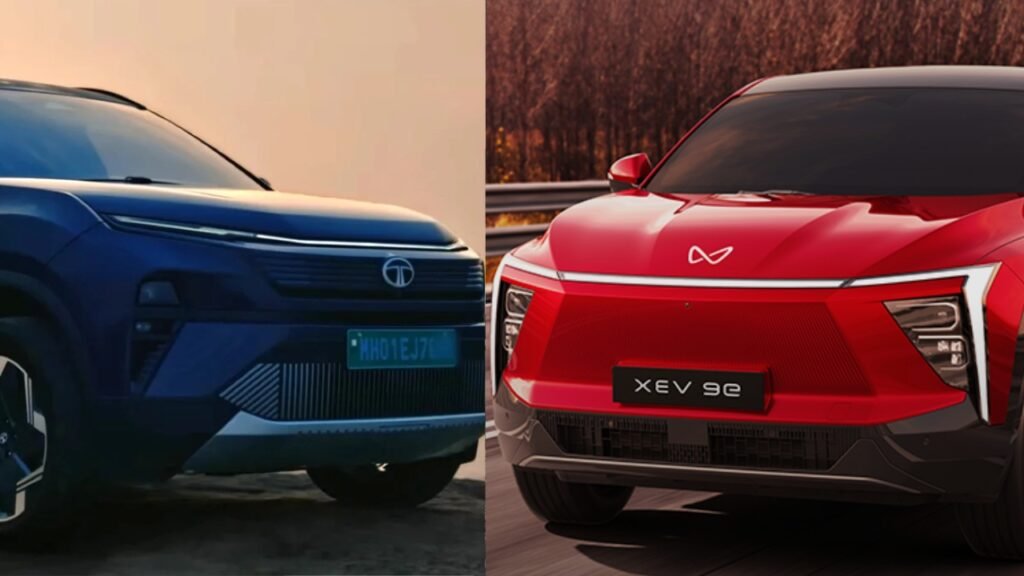The electric SUV segment in India is heating up — and it’s not just because of rising temperatures. (Ok Sorry For that!) The Tata Harrier EV and the Mahindra XEV 9e have entered the ring, bringing performance, futuristic design, and compelling features to the forefront. But which one edges ahead in the real world? Let’s break down how these two electric powerhouses stack up across design, performance, features, safety, and price.

Design
The Tata Harrier EV leans on its strong ICE (internal combustion engine) roots. Visually, it retains the bold, upright stance of the diesel Harrier, but with EV-specific enhancements — a sealed grille, reworked bumpers, aerodynamic wheels, and a sleeker fascia that modernizes its look while retaining familiarity.
In contrast, the Mahindra XEV 9e is a born-electric SUV, built on the all-new INGLO platform. The design language is distinctly futuristic — think coupe-style roofline, connected LED tail lamps, flush door handles, and a minimalistic front that screams sci-fi. While the Harrier offers rugged charm, the XEV 9e delivers sleek sophistication.
Performance & Powertrain
The Harrier EV is Tata’s first dual-motor AWD EV, producing a combined output of 396 PS (158 PS front + 238 PS rear) and hitting 0-100 km/h in just 6.3 seconds. Offered with 65 kWh and 75 kWh battery options, it supports 120 kW fast charging and boasts a real-world-friendly claimed range of up to 622 km.
The XEV 9e offers two battery variants — 59 kWh and 79 kWh — with power outputs of 228 PS and 286 PS respectively. Acceleration from 0-100 km/h comes in at 6.8 seconds, and it shines on the range front with a class-leading 656 km on the 79 kWh version. With support for 180 kW DC fast charging, it can juice up from 20–80% in just 20 minutes — slightly quicker than the Harrier’s 25 minutes.
If raw power and AWD are your priorities, the Harrier pulls ahead. If maximum range and rapid charging are what matter most, the XEV 9e takes the lead.
Interior & Features
The Harrier EV boasts a cinematic 14.53-inch Harman infotainment screen — the world’s first Neo QLED display in a car. It also includes wireless charging, powered tailgate, dual-zone climate control, autonomous parking with summon mode, and even underbody camera views — a godsend for off-roading.
The XEV 9e, however, goes all in on tech flair. Its triple-screen layout (three 12.3-inch displays) spans the dashboard, augmented reality heads-up display, and two rear entertainment screens elevate it to luxury lounge territory. It also features mood-sensing cameras, in-car video calling, and a superior 16-speaker audio system.
While the XEV is flashier and feels more futuristic, the Harrier focuses on utility and off-road capability — including six terrain modes, Off-Road Assist, and Vehicle-to-Load (V2L) and Vehicle-to-Vehicle (V2V) charging.
Safety
Safety is a key battleground — and both SUVs come well-equipped.
The Harrier EV offers 7 airbags, Level 2 ADAS with 20+ features, 540-degree surround view, an electronic parking brake with auto hold, and even a “transparent hood” view for off-roading. It also includes Hill Descent Control, SOS function, and a Digital IRVM with video recording.
The XEV 9e also gets 7 airbags (in higher trims), Level 2+ ADAS, 360-degree camera, auto-defogging windshield, and a rear defogger. However, many of these features are limited to its pricier variants, giving the Harrier a stronger safety value at its base price.
Size
Dimension-wise, the XEV 9e is the larger SUV — 4,789 mm in length compared to the Harrier’s 4,607 mm. It also has a longer wheelbase and larger boot (663 litres vs Harrier’s 503 litres), making it the better option for families and road trips.
However, the Harrier’s superior ground clearance and 600 mm water-wading capacity make it more suitable for challenging terrain. If weekend adventures are your thing, the Harrier’s off-road focus is a big plus.
Price
Tata has priced the Harrier EV aggressively, with an introductory tag of ₹21.49 lakh (ex-showroom). Mahindra’s XEV 9e starts at ₹22.65 lakh and goes up to ₹31.25 lakh for higher trims.
That means the Harrier EV currently holds the title of most affordable AWD electric SUV in India — an important distinction in a price-sensitive market.
Verdict: Which One’s for You?
The Tata Harrier EV is for those who want a high-performance EV with AWD, rugged capability, and a premium tech experience — all at a competitive price. It’s a clear choice for enthusiasts, off-road lovers, and those seeking value.
The Mahindra XEV 9e, on the other hand, offers a futuristic design, more cabin space, tech-loaded interiors, and a longer range — making it ideal for urban buyers and families who prioritize luxury and comfort.
In the end, both SUVs are raising the bar for what Indian EVs can deliver — and that’s a win for everyone.
Automotive Enthusiast. A Long Roadtrip is All You Need!

